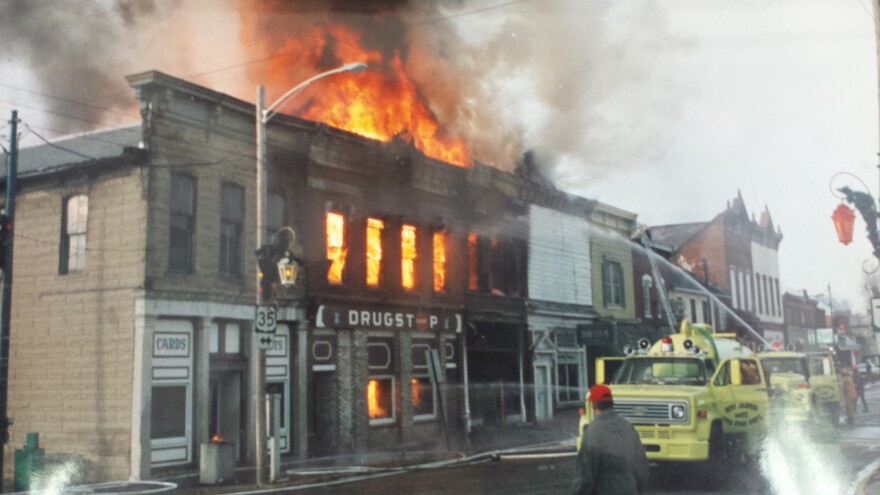Here in southwest Ohio, it’s not hard to find small country towns that were thriving fifty years ago but are now struggling to survive.
They’re all subject to similar economic forces – but each one has its own story.
In Greene county, the Village of Jamestown has just about 2,000 people today – slightly more than 50 years ago, - but what Jamestown has lost – is its vital downtown.

In the 1900’s Jamestown, Ohio, was described as “one of the most wide-awake, enterprising and prosperous towns in Greene County”. Now the Victorian era storefronts lining the downtown street are mostly vacant.
Ted Sessler is a lifelong resident of Jamestown and the town barber. What he doesn’t hear in his shop, he hears out on the streets. Ted’s Barber shop sits in the center of the village by the towns only stop light. He describes what it was like in the 50’s.
“We had a lot of businesses here. We had everything we needed. We didn’t even have to go to Xenia for anything. We had a movie theatre, two meat markets, five barber shops, two restaurants, one bank, dry cleaning, shoe store, two car dealerships. We had everything we needed, and we were all farmers. So they all came to town on Saturday night and you couldn’t even walk down the street. 5,000 people would be in town on a Saturday night.”
This was also the time when a former farm out on the western edge of the village was developed into a man made lake ringed by houses. The Shawnee Lake subdivision doubled the population of Jamestown in just one decade, as people from Dayton and Xenia relocated to the area.
“It brought a lot of people from the city into the local community,” say’s Ted. “Which forced us to build schools and update a lot of our fire department and police department. So we have progressed in that area, but the downtown section needs a lot of revamping.”
Ted points to several fires as one of the turning points for the town. Across the street from his barber shop, for example, were four buildings that all burnt down.
One of those buildings houses Something New Florist, which has a going out of business sign in the window. Owner Joanne Snell has been here for 43 years and ready to retire. Now in her 80’s, Snell says she’s just worn out.

Although the fire’s in the ‘90’s were a big blow to her business, it was compounded by the construction of Interstate 35 in 2001.Traffic from the old highway that went through the center of downtown was now bypassing Jamestown.
“The local traffics still here,” says Snell. “But as far as the traffic passing through town, that doesn’t happen anymore.”
Ted agrees, “It hurt my business because people would come up to the traffic light, look over at me and I was standing on the corner or sitting on the bench out there and they’d say ‘can I get a haircut’, and I’d say ‘shit, yeah come on!’. So I don’t have that no more cause they go around the bypass.”
The death blow for Jamestown came in 2008, when shipping giant DHL closed in the neighboring town of Wilmington and 7,000 people lost their jobs. Unemployment in Jamestown went from 5 percent to 10 in one year.
“It really tore us up,” Ted reflects as he trims a customer’s hair, “ Yes, that was a major loss, yeah. It almost happened overnight.”
In 2010 the Village received almost two million dollars in federal money as part of the Neighborhood Stabilization Program, which was created to help restore neighborhoods hit by the country’s foreclosure crisis. It was used to demolish three vacant homes and rebuild new houses on the lots which the town then sold in a sealed bidding process. Two of those houses were located on a side street within the village, and one was at Shawnee lake.
None of that money went to the blighted downtown area.
“It could have made a real dent in this place, oh yes,” Ted says, “And you got to have people with the vision that want to do that. And until you get those people it keeps going down, down, down.”
Two doors down from Ted’s barber shop, Sherry Marsden and her husband hope to be a part of that vision. They bought the vacant three story former Harley Davidson building and Sherry’s mother moved her hair salon from Xenia into the newly renovated storefront.
“It was a good opportunity and my husband decided to go for it’” say’s Sherry from inside the store watching a local woman is having her hair cut. “ I would love to see somebody else open something. I mean there’s so many beautiful buildings. I would love a coffee shop.”
When the florist shop closes down this month, Sherry and Ted Marsden will be two of the last three businesses left in the downtown strip.




